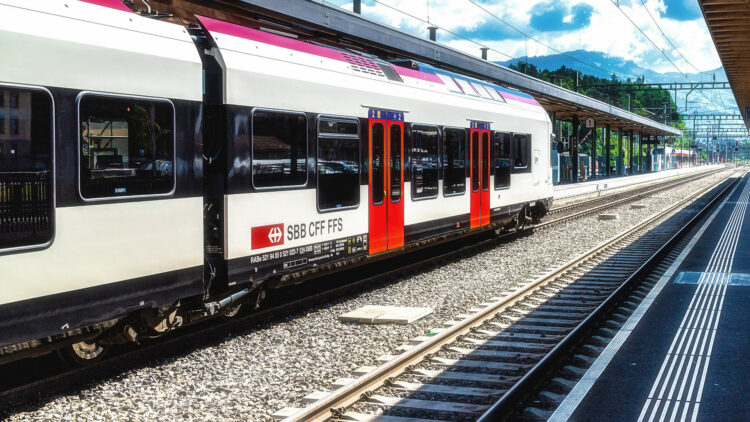Sun-Ways, a Swiss company, is conducting an experiment to determine the feasibility of embedding solar panels between railway tracks. The pilot project is taking place in Buttes, a small railway station near the French border. Switzerland has one of the world’s most carbon-neutral power grids, with 34% of its energy coming from nuclear reactors and the remaining 66% from renewables, mostly hydroelectric plants. As the demand for clean energy continues to rise, the country is participating in a trial program to explore the practicalities of utilizing solar panels within rail tracks.
The pilot project in Buttes will cover only 100 meters of track but will allow Sun-Ways to assess the logistics of installing solar panels with a high level of automation from underneath a specially fitted rail carriage. The panels will be equipped with special clamps to secure them in place, and if successful, they can be easily removed for maintenance. Sun-Ways is also considering fitting passenger trains with cylindrical brushes to clean the panels as the trains pass over them.
In terms of power generation, Sun-Ways estimates that around 2% of Switzerland’s energy could come from this type of solar panel installation, equivalent to 1-2 terawatts per hour. With advancements in panel technology, this amount could potentially increase. However, the impact on other countries would vary based on factors such as track length per capita. For example, the UK may only be able to fulfill 1% of its solar power demand through such a project. Nevertheless, once deployed, this system could provide “free” power and reduce dependence on imports, thereby stabilizing prices during times of trouble.
There are, however, several challenges to consider, including initial costs, repair/upkeep expenses, and the risk of theft. Sun-Ways is conducting the pilot project to gather data on these variables and will release their findings to the public.
Overall, the experiment in Buttes aims to explore the practicality and potential of embedding solar panels within rail tracks. If successful, this innovative approach could contribute significantly to Switzerland’s clean energy goals and potentially inspire similar projects in other countries.
Is it possible for solar panels placed between rail tracks to generate substantial power?
The global pursuit of clean and renewable energy has led to widespread interest in solar power as a viable alternative to traditional energy sources. Governments, organizations, and individuals alike are searching for innovative solutions that maximize the generation of solar energy. One such solution, gaining traction in recent years, is the installation of solar panels between rail tracks. This novel approach aims to utilize the available space more efficiently and generate substantial power. However, many questions persist regarding the feasibility and effectiveness of this unique application.
One major benefit of this idea is the efficient use of space. Rail tracks traverse vast expanses of land, often underutilized except for train transportation. By placing solar panels between these tracks, valuable real estate can be leveraged effectively. Additionally, railways typically span across different terrains, allowing for an optimal utilization of diverse environments, such as desert regions or rural areas with high solar irradiation.
Another advantage of this concept is the potential synergy between railways and solar power generation. Rail tracks are often positioned in long, straight stretches, ensuring that the installed solar panels would receive maximum exposure to sunlight throughout the day. Moreover, as trains are primarily powered by electricity, the generated solar energy could be directly utilized for railway operations, resulting in reduced reliance on fossil fuels and decreased greenhouse gas emissions.
However, several challenges must be addressed to determine the feasibility of this approach. Firstly, safety concerns regarding the installation of solar panels between rail tracks need to be carefully evaluated. Specialized design and technical implementation should ensure that the panels are securely anchored and adequately protected from potential damage. Furthermore, the panels should not interfere with railway maintenance or construction activities, ensuring the safety of workers and passengers.
Additionally, the impact on rail operations must be considered. Factors such as shading caused by the panels and potential debris accumulation could affect track maintenance and train scheduling. A comprehensive study should be conducted to assess the possible disruptions and outline strategies to mitigate any risks that may arise.
In terms of power generation, the efficiency of solar panels placed between rail tracks also warrants investigation. While the large expanse of rail infrastructure offers substantial potential, it is crucial to analyze the optimal angle and positioning of the panels to maximize energy output. Simulation models simulating the various geographical locations and taking into account factors like shading and maintenance should be developed to accurately estimate the solar energy generation potential.
Moreover, the economic viability of large-scale implementation must be carefully examined. The costs associated with installing, operating, and maintaining these solar panels need to be evaluated against the potential benefits and long-term financial returns. Measures such as government support, innovative financing models, or tax incentives may be necessary to make this initiative economically feasible.
Despite the challenges, the idea of installing solar panels between rail tracks to generate substantial power offers a promising avenue to increase renewable energy production. By utilizing underutilized land and existing railway infrastructure, this unique application has the potential to enhance sustainability efforts and contribute to the global transition towards cleaner energy sources. Further research, rigorous planning, and thorough evaluation are imperative to determine the viability of this concept and its integration into future energy strategies.

